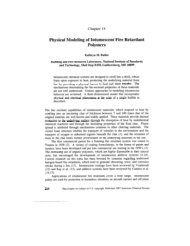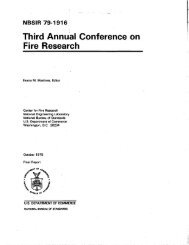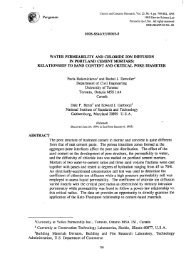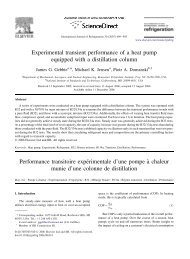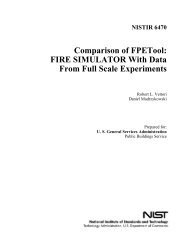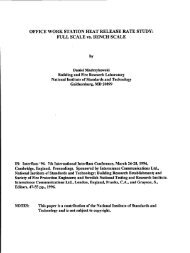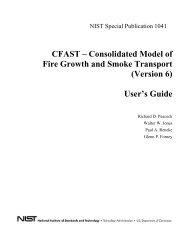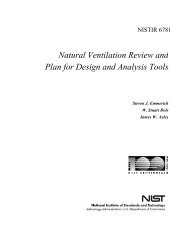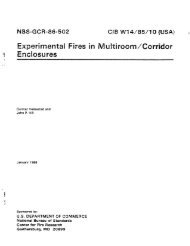Study of Technology for Detecting Pre-Ignition Conditions of ... - NIST
Study of Technology for Detecting Pre-Ignition Conditions of ... - NIST
Study of Technology for Detecting Pre-Ignition Conditions of ... - NIST
Create successful ePaper yourself
Turn your PDF publications into a flip-book with our unique Google optimized e-Paper software.
CPSC-MG95-1145<br />
a good cmdidate <strong>for</strong> such measurements. The burner or pan temperature on the electric range<br />
could be used in conjunction with other signatures if threshold temperate or integrated time and<br />
temperature behavior were utilized to detect pre-i~ition wnditions.<br />
3.2.2 Plume<br />
Figures 10 through 16 show the plume thermocouple grid temperatures as a function <strong>of</strong><br />
tin-w <strong>for</strong> a test <strong>of</strong> oil heated on an electric range with the range hood <strong>of</strong>f. The grid diagram <strong>of</strong><br />
Figure 3 helps in interpreting these figures. Figure 10 shows the vertical pr<strong>of</strong>ile <strong>of</strong> the pancenterline<br />
~mpera@es above the bwmer. Be<strong>for</strong>e ignition, none <strong>of</strong> the temperawes exceeded<br />
100 ‘C. The plumes were relatively cool compared to the pans and food below. At the highest<br />
point above the burner, the tempera~re only reached about 40 “C. Figures 11 and 12 show the<br />
vertical temperature pr<strong>of</strong>iles 7.6 cm to the left and right (when facing the range) <strong>of</strong> the pan<br />
centerline. The temperawres left <strong>of</strong> center were much less than those right <strong>of</strong> center. This<br />
implies a high degree <strong>of</strong> asymmehy in the plume. At 16.8 cm above the burner, the temperature<br />
right <strong>of</strong> the pan centerline was even 10 ‘C greater than the centerline temperature. Figure 13<br />
shows the vertical temperature pr<strong>of</strong>ile 15.2 cm to the left <strong>of</strong> the centerline. Of all <strong>of</strong> the vertical<br />
tempera~res, these were the coolest.<br />
Figures 14, 15, and 16 show the changes in horizontal temperatures with time along lines<br />
16.8 ~m, 37.1 cm, and 67.6 cm above the burner, respectively. These figures also demonstrate<br />
that the plume temperatures were shifted to the right <strong>of</strong> center. The plumes in the tests conducted<br />
on the hi~-ou~ut gas range tended to shift to the left slightly. In every case, while the degree<br />
was different <strong>for</strong> each test, the plumes tended to lean away from the center <strong>of</strong> the range.<br />
Figure 17 shows a comparison <strong>of</strong> the centerline temperamre 37.1 cm above the burner <strong>for</strong><br />
all <strong>of</strong> the food and rmge-hood ~mbinations heated on the electric range. The behaviors <strong>of</strong> the<br />
same foods were similar. Figure 18 shows a comparison <strong>of</strong> the centerline temperature 37.1 cm<br />
above the burner <strong>for</strong> all <strong>of</strong> the food and range combinations heated on the high-output gas range.<br />
The bacon temperature curves are similar, but the oil curves differ by about 20 ‘C and show<br />
difierent trends. Sugar ignited very quickly, even relative to the parallel electric-range test.<br />
These figures show that the range hood affects the ignition process and the plume to a minor<br />
degree at most.<br />
The plume may be a di~~cult location to position a tempera~re measuring device as a<br />
range pre-ignition detector. The temperatures are not very high in the plume and do not change<br />
significantly with time during heating.<br />
3.2.3 Range and Range Hood<br />
Figure 19 shows the tempera~res <strong>of</strong> the range and range-hood themomuples as a<br />
function <strong>of</strong> time <strong>for</strong> a test <strong>of</strong> oil heated on an electric range with the range hood <strong>of</strong>f. The outside<br />
surface <strong>of</strong> the hood actually cooled prior to ignition. The range surface thermocouples equidistant<br />
from the burner have similar tempera~re curves. The temperature <strong>of</strong> the range beneath the<br />
burner w-passed 200 ‘C which means that the space beneath the burner is a relatively hot<br />
environment.<br />
26<br />
.-



